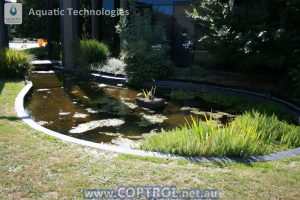How to control algae in Ornamental Ponds and Fountains
Shallow ponds ideal for growing algae
Frequently fish are added to the pond and they too assist the growth of algae. Fish faeces are an excellent source of nutrient for algae. Often fish are over fed and the excess feed falls to the bottom and as it rots is another source of nutrient. Other sources of nutrient are fallen leaves or fertilizer. This excess of nutrient leads to algal blooms which in turn take dissolved oxygen out of the water and leads to fish suffocation from lack of oxygen.
Fish precautions
|
• The water temperature of the pond must be 16C (61 F) or more
• The calcium carbonate of the water must be 50 PPM (50mg/litre) • The water must be aerated • You should read and heed Coptrol use in Aquaculture • Dead and decomposing algae will use the dissolved oxygen in the water. So where fish are present, and there is inadequate aeration, it is recommended that a third of the pond be treated at a time, at intervals of at least 7 days, to allow the fish to escape to oxygenated water. |
Dose recommendations
| If algae is a problem in your ornamental pond or fountain follow this 5 step method to keep your waters clear and bright.
1. First identify the algae present. Please use our guide here for more information. This page explains common algae within Australia. 2. Now calculate the volume of water to treat. Ignore depths below 1 metre. Please refer to our “Quantities” page to calculate the amount of water to treat. 3. Next calculate the amount of Coptrol needed. An easy way to calculate is: • If the algae is fine and free floating use 2 mL of Coptrol per 1000 Litres (1 cubic metre) of water. That is equivalent to 2 Litres of Coptrol per 1000 square metres of surface area. • If the algae is long and stringy use 5 mL per 1000 litres of water (1 cubic metre) or 5 Litres per 1000 square metres of surface area. 4. Dilute the required amount of Coptrol using a 1:10 or even a 1:20 Coptrol water dilution. 5. The best application method is by spraying. Apply on a sunlit wind free day when algae first appear. If this is impractical, please refer to our “Application” page on how to apply Coptrol. |



